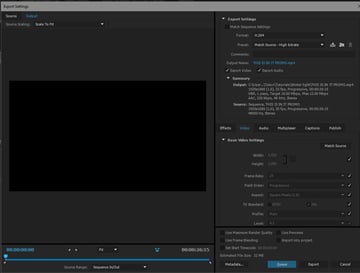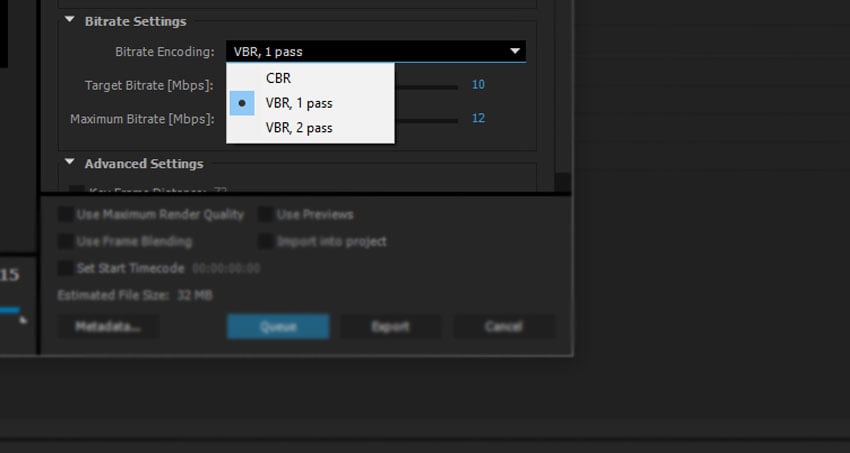Should I Export Using The Youtube 1080 Preset In Premiere
You lot've made your film, bang-up! Now how do you get your finished video out of Premiere Pro in the advisable format? In that location are export settings for everything, merely nosotros'll go into the ones yous're almost probable to need in this tutorial. Here's a quick summary of the parts of the consign process we cover here:
- The Nuts: How to Export Video from Premiere Pro: file export basics and essential settings (with tutorial video).
- How to Export Video for Collaborating and Storing Files: how to send clips back and along when a team are working on the aforementioned project, when you lot should keep file formats the same, and when to keep the best quality footage you have.
- How to Export Video for the Platforms: a cursory look at codecs, especially H.264 and H.265 to use for online platforms; when you tin choose a preset and when to drill downwards further into the options and make purposeful changes to your export.
- Variable Formats
- How to Understand Constant vs. Variable Bitrate: what the difference is, why it matters, and how Premiere Pro volition interpret your choice in terms of a trade-off between file size and quality.
1. The Basics: How to Export Video From Adobe Premiere
At that place is no i-stop shop for export settings, unfortunately! The skillful news is you lot don't need to know the ins and outs of bitrates and codecs to get something of high quality out of Premiere Pro and to your desired third party.
Brand new to exporting video? This lesson from David Bode's gratis Adobe Premiere tutorial covers everything you need to become started.

This course is very comprehensive and includes lessons on helping you to organise your files outside Premiere Pro, how to import avails and prepare a project, and of class how to learn editing essentials like making cuts, adding audio and video effects, and much more.
2. How to Export Video for Collaborating and Archives
If you're lucky enough to accept a trusted team working with you lot to produce your moving picture, so you might be sending clips back and forth to each other, and ideally you lot won't want those to be huge files. Premiere Pro has a dandy Shared Projects feature withProjection Locking, where multiple editors can piece of work on a film without overwriting each other's work.
If you tin't, or prefer not to use this characteristic, then how to consign really depends on what the other person volition be doing with the footage. If they're editing it for inclusion in the flick, then you'll probably want to send over the highest quality available: the original files straight from the camera. If they're just calculation some notes or markers that you can and so overlay over your own footage, then you lot can export at a lower quality.
Keeping your formats the same will aid your timeline function better, and if you're applying a colouring outcome or similar edit, yous know it will take the same—or close to the same—upshot correct across the board.
The aforementioned logic applies when you're storing archival footage for posterity—ever keep the best versions of the material you can. It'due south a trade-off with space and a best guess at what you might need in the time to come.
Press That Button: Maximum Render Quality
Premiere Pro can use hardware and software rendering to produce a final image. Software rendering is slower, just useful for some types of video.
Clicking Render at Maximum Quality in the consign dialog tells Premiere to go ahead and use software rendering if needed, typically if you've scaled, rotated, or repositioned function of your composition. Information technology doesn't engage if yous don't need information technology, so go ahead and plough it on when you gear up your sequence and when you hit Export.

3. Auto-Reframe
Square and vertical video is here to stay. Here'southward Tom once again with how to use Car-Reframe to relieve a agglomeration of fourth dimension in making all those versions.

four. Using H.264 and H.265 Video Codecs
The standard for uploading video is H.264, which is designed to let you transport high-quality video without information technology needing to exist ridiculous file sizes. H.264 was the standard for Blu-ray discs and is accepted by Vimeo, YouTube, and other popular online video outlets.



We at present have H.265 (HEVC), the successor to H.264, which promises 25–50% better information compression than its predecessor, and back up for formats like 8K (Ultra HD). Whilst I'chiliad certain the super tech bods could explain this in a lot more particular than I can, for those of us who want the short version: it encodes your video at the lowest bitrate it can, while keeping your image and audio loftier quality.
What Are Video Codecs?
Acodec is method for compressing (coding), and then decompressing (de-coding), a video file, and they work a bit similar JPEG files for images. Video codecs let you lot compress video with high-quality and a reasonable file size, though each comes with its gear up of advantages, trade-offs, and limitations. For more than details, check out Tom Light-green'due south tutorial about video codecs here on Envato Tuts+.
H.265 does, yet, require more than processing ability, which is probably something to bear in mind depending on the specs of your computer. If you're using a slightly older version of Premiere Pro, y'all might only have the H.264 selection. Another very important consideration is that older computers just won't have the H.265 codec, which means you lot tin can't watch the video unless y'all download it, at a (minor) price. If you're uploading to YouTube or another video host this doesn't matter, though, equally they return multiple versions anyway.
How to Render Video to H.265
Once you've selected H.265 in Premiere Pro, yous'll be presented with some more than specific options for your video, and it depends on your requirements equally to what you lot'll select. The most mutual ones you'll probably use are the presets for YouTube or Vimeo, which volition then requite you the option to tweak other settings. You need to make sure that your source and output match in the settings. If something similar your ratio is different, brand certain that it'south deliberate (like if you're downsizing); otherwise, they should match. In the Video box beneath, yous can actually clickLucifer Source which volition help make certain your settings match.
Here's a step-by-step lesson with Dave nigh compressing to H.265 from his free Premiere Pro FAQ course:

The choices you make here are ones yous want to produce the highest quality possible, and then that when you upload to YouTube or Vimeo and they compress your video further, it still looks good. The Premiere Pro breakdowns are pretty expert, so you don't need to worry too much about making changes within the standard profiles if you aren't confident nearly it. For web delivery, make sureContour (inVideo) is set toHigh.
If you have a gratis Vimeo account, recollect that although you can upload 1080p, it'll be downsized to 720p, so information technology's worth choosing the 720 export choice in Premiere Pro.
5. Constant vs. Variable Bitrate
Part of the hierarchy in the export settings with H.265 (or 4) is the selection to choose between constant and variable bitrates. Constant is, as you'd think, a standard bitrate across the whole flick. Variable bitrate lets you set up target and maximum bitrates, which means Premiere will aim for a sure amount of data throughout your video.



Images that are more complicated demand more data. With a variable bitrate, Premiere will up the allowance co-ordinate to your maximum bitrate setting, keeping the bitrate of simpler shots downwards, so that your overall file size tin be lower. If your ultimate destination is the web, you're going to want a loftier bitrate for the reasons I mentioned earlier: it'll get compressed again when you upload to various social media.
Client Considerations and File Sizes
If y'all're sending your project to a client equally an exported video, ask them about their requirements, considering if you recollect about a characteristic length moving picture, for instance, rendering that out at highest quality might be a lot more than their auto tin can handle, and it might testify difficult to really send. Information technology might even be wise to return a couple of versions: 1 a much more compressed version, so that your client has options.
In Summary
Basically, what y'all need to know is what y'all want in the exported video. Is it quality that matters? Or maybe you'll take a bit less image quality for a speedy download. And so you need the patience to potentially make more than one version or render of the video to fulfil that.
A Quick Exporting Rule of Pollex
A expert dominion is that if size isn't an effect, export to the highest settings and quality you can. If size is an issue, then brainstorm a gentle trade-off between size and space. Information technology's a frail residue, but certainly when it comes to exporting for online utilize, you're in fairly rubber easily with the H.264 option.
The best way to learn what y'all need for each eventuality is to find out the quirks of the third-party uploaders you're using, like Vimeo downsizing on free accounts. That way, you can brand the all-time decisions for your video, knowing that actress compression won't ruin information technology. Learn to trust your eyes, and you lot can start to customise those settings as you get more confident.
Side by side Steps for Better Video Exports From Premiere Pro
Now that you lot know the basics of exporting your video from Premiere Pro, there are another things you can beginning to think most.
Captioning Your Video
Adding subtitles or closed captions to your video can really help with engagement and accessibility. On Facebook, 85% of people are watching videos without the audio on, so closed captions can make certain they stick around and absorb your message. To learn more than, endeavor How & Why to Add Closed Captions to Social Media Videos. You don't necessarily have to type it all out yourself either: check out how yous can Subtitle and Explanation Your Videos Automatically Using Artificial Intelligence.
Making Adjustments for Different Social Channels
Where once we'd have aghast at the idea of square and vertical video, we now embrace information technology when it comes to social media outlets like Instagram. Find out How to Utilise Vertical Video Finer and How to Employ Square Video (For Social Media).
Making More Advanced Edits
Premiere Pro has really avant-garde in recent years, and at present y'all're able to create more advanced animations and effects correct in Premiere Pro, rather than having to flip to Later on Effects. Learn How to Quickly Modify Flick Styles in Premiere Pro With LUT Presets and fifty-fifty how to outset creating your own templates with Premiere Pro for the Essential Graphics Panel.
Endeavor These Premiere Pro Presets
Did you know that you can now download free Premiere Pro templates from Mixkit? Cheque out the wonderful assortment of templates over at that place, or read these articles for fifty-fifty more options.
Did you find this post useful?
Source: https://photography.tutsplus.com/articles/the-best-export-settings-in-premiere-pro--cms-33002
Posted by: solistheaks.blogspot.com


0 Response to "Should I Export Using The Youtube 1080 Preset In Premiere"
Post a Comment